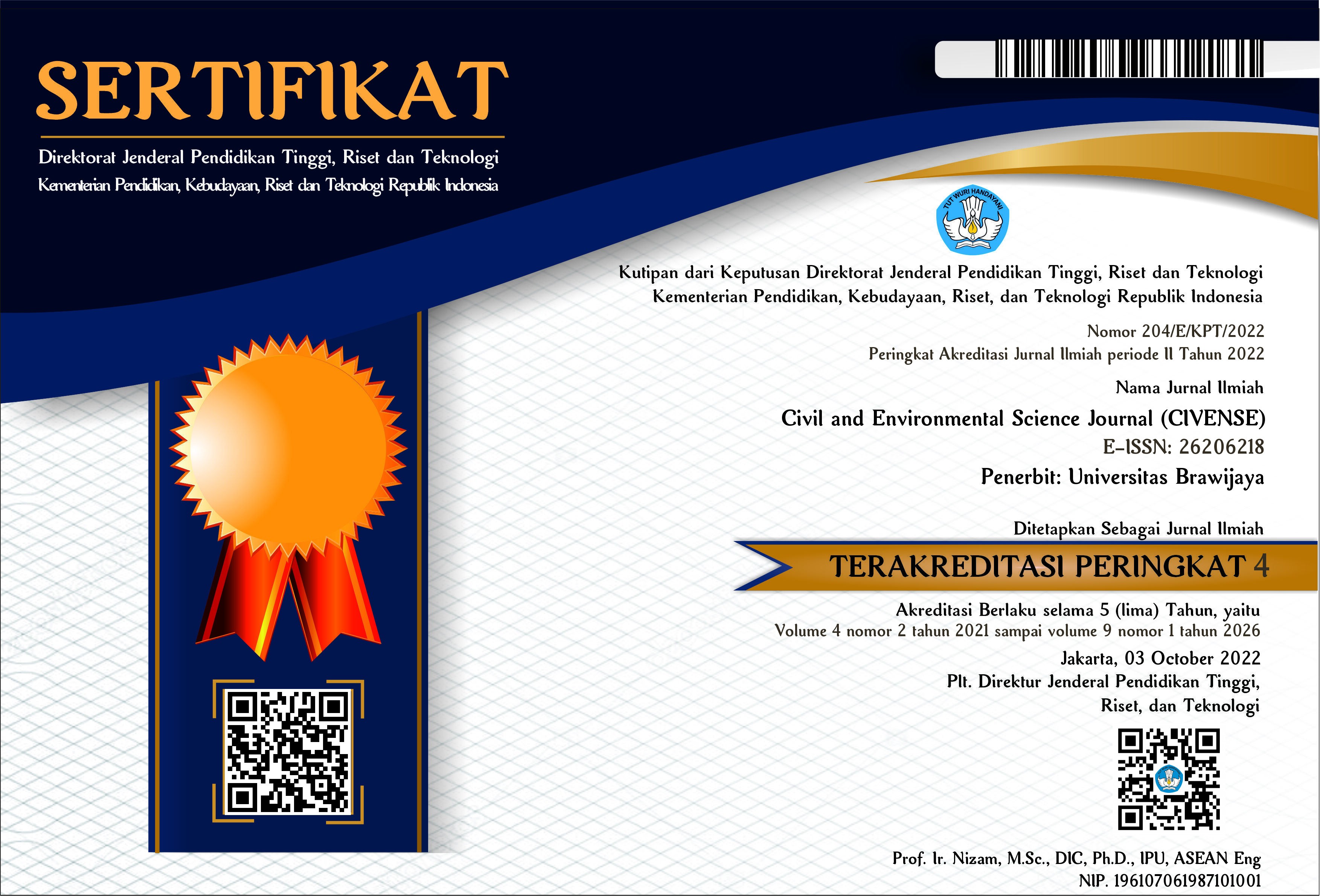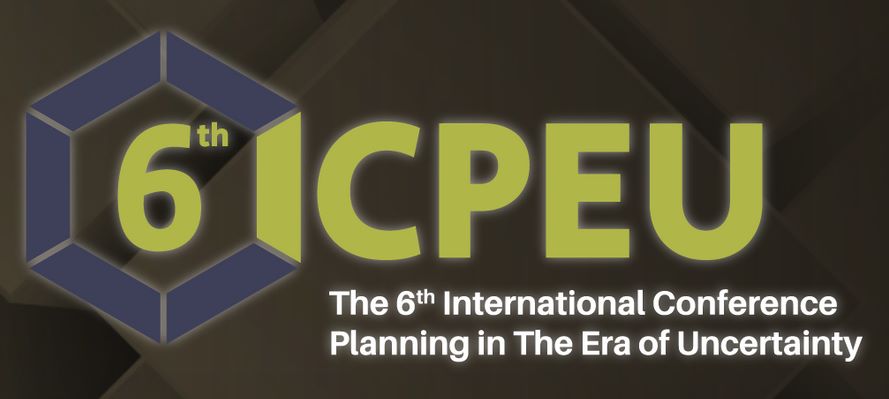Factors Affecting Commuters' Intentions in Using Park and Ride (P&R) Facilities Based on Theory of Planned Behavior
DOI:
https://doi.org/10.21776/ub.civense.2022.00502.4Keywords:
Park and Ride, Transportation Demand Management, Commuters, Theory of Planned Behavior, Structural Equation ModelAbstract
Park and Ride (P&R) is a form of transportation demand management closely related to commuting activities. Several developed countries, such as the UK, Canada, China, and Hong Kong already implemented P&R with a high level of effectiveness and success in overcoming the congestion problems in the city center, low use of public transportation, and air pollution. However, in developing countries, the various positive impacts of P&R still have not been able to encourage commuters' intentions to use these facilities. The level of P&R use at Sidoarjo Station is still relatively low (44.3%). Behavioral is one of several keys to the success of P&R that depends on intention and ability. The intention is the result of knowledge, social, and infrastructure that can support the use of public transport and P&R. This study aims to identify factors that can influence commuters' intentions to use P&R at Sidoarjo Station based on the theory of planned behavior using SEM analysis. The results showed that P&R and public transportation conditions as perceived behavioral control were the most influential factors on commuter intentions. The conditions of public transportation (including availability and location) and the quality of P&R facilities are also essential considerations for commuters using P&R.
References
X. Zhao, Y. Li, and H. Xia, “Behavior decision model for park-and-ride facilities utilization,” Adv. Mech. Eng., vol. 9, no. 7, pp. 1–9, 2017, doi: 10.1177/1687814017708907.
K. Huang, Z. Liu, T. Zhu, I. Kim, and K. An, “Analysis of the acceptance of park-and-ride by users: A cumulative logistic regression approach,” J. Transp. Land Use, vol. 12, no. 1, pp. 637–647, 2019, doi: 10.5198/jtlu.2019.1390.
M. K. S. Perera, V. Waidyasekara, and S. Dissanayake, “Commuters Perception Towards The Bus Base Park and Ride Implementation in Colombo City Limit,” CINEC Acad. J., vol. 5, no. 1, pp. 36–45, 2021.
I. Fajar and A. Djunaedi, “Factors That Influencing Informal Park and Ride Facility Choice in Indonesia: Case Study of Kendal Regency,” J. Ilm. Univ. Batanghari Jambi, vol. 20, no. 1, p. 54, 2020, doi: 10.33087/jiubj.v20i1.789.
F. R. Widayanti and A. R. Pattisinai, “Investigate Park and Ride performance assessment for the better sustainable urban transportation in Surabaya,” IOP Conf. Ser. Mater. Sci. Eng., vol. 1098, no. 2, p. 022019, 2021, doi: 10.1088/1757-899x/1098/2/022019.
P. Dirgahayani and H. Sutanto, “The effect of transport demand management policy on the intention to use public transport: A case in Bandung, Indonesia,” Case Stud. Transp. Policy, vol. 8, no. 3, pp. 1062–1072, 2020, doi: 10.1016/j.cstp.2020.03.004.
A. R. Nurkhariza and S. Nurlaela, “Faktor-faktor yang Memengaruhi Permintaan Commuter Line Berdasarkan Karakteristik Fasilitas Park and Ride di Stasiun Sidoarjo,” J. Transp. Sist. Mater. dan Infrastruktur, vol. 1, no. 2, p. 106, 2019, doi: 10.12962/j26226847.v1i2.5035.
DLLAJ, “Masterplan Transportasi Kota Surabaya,” 2017.
A. N. H. Ibrahim, M. N. Borhan, and R. A. O. K. Rahmat, “Understanding users’ intention to use park-and-ride facilities in malaysia: The role of trust as a novel construct in the theory of planned behaviour,” Sustain., vol. 12, no. 6, 2020, doi: 10.3390/su12062484.
A. Asapa, “Park and Ride Sebagai Bagian dari Pelayanan Kereta Api Perkotaan Bandung,” J. Perenc. Wil. dan Kota, vol. 25, no. 2, pp. 157–173, 2014, doi: 10.5614/jpwk.2015.25.2.5.
E. Macioszek and A. Kurek, “The use of a park and ride system a case study based on the City of Cracow (Poland),” Energies, vol. 13, no. 13, 2020, doi: 10.3390/en13133473.
M. Suryandari, A. Wicaksono, and I. W. Agustin, “The Implementation of Park and Ride at Bekasi Station,” Tataloka, vol. 17, pp. 172–185, 2015, [Online]. Available: https://doi.org/10.14710/tataloka.17.3.172-185.
S. Irawati, I. W. Agustin, I. Rini, and D. Ari, “Potensi Park and Ride Dalam Mendukung Penggunaan Kereta Api Komuter di Stasiun Sidoarjo,” Plan. Urban Reg. Environ. Vol., vol. 10, no. 3, pp. 159–168, 2021.
H. Gan and X. Ye, “Will commute drivers switch to park-and-ride under the influence of multimodal traveler information? A stated preference investigation,” Transp. Res. Part F Traffic Psychol. Behav., vol. 56, pp. 354–361, 2018, doi: 10.1016/j.trf.2018.05.015.
W. Clayton, E. Ben-Elia, G. Parkhurst, and M. Ricci, “Where to park? A behavioural comparison of bus Park and Ride and city centre car park usage in Bath, UK,” J. Transp. Geogr., vol. 36, pp. 124–133, 2014, doi: 10.1016/j.jtrangeo.2014.03.011.
M. Ashraf Javid, M. Abdullah, N. Ali, and C. Dias, “Structural equation modeling of public transport use with COVID-19 precautions: An extension of the norm activation model,” Transp. Res. Interdiscip. Perspect., vol. 12, no. October, p. 100474, 2021, doi: 10.1016/j.trip.2021.100474.
X. Zhang, D. Liu, Y. Wang, and H. Du, “Behavioral Intentions of Urban Rail Transit Passengers during the COVID-19 Pandemic in Tianjin , China : A Model Integrating the Theory of Planned Behavior and Customer Satisfaction Theory,” vol. 2021, 2021.
E. Macioszek and A. Kurek, “The analysis of the factors determining the choice of park and ride facility using a multinomial logit model,” Energies, vol. 14, no. 1, 2021, doi: 10.3390/en14010203.
T. Zijlstra, T. Vanoutrive, and A. Verhetsel, “A meta-analysis of the effectiveness of park-and-ride facilities,” Eur. J. Transp. Infrastruct. Res., vol. 15, no. 4, pp. 597–612, 2015, doi: 10.18757/ejtir.2015.15.4.3099.
J. K. Liang, T. Eccarius, and C. C. Lu, “Investigating factors that affect the intention to use shared parking: A case study of Taipei City,” Transp. Res. Part A Policy Pract., vol. 130, no. September, pp. 799–812, 2019, doi: 10.1016/j.tra.2019.10.006.
K. Zhang, H. Guo, G. Yao, C. Li, Y. Zhang, and W. Wang, “Modeling acceptance of electric vehicle sharing based on theory of planned behavior,” Sustain., vol. 10, no. 12, pp. 1–14, 2018, doi: 10.3390/su10124686.
H. A.-R. Lubis, B. Hasibuan, and M. Farda, “Users’ Perception of Private Park and Ride Facilities in Cawang Area, Jakarta, Indonesia,” J. Tek. Sipil, vol. 26, no. 3, p. 205, 2019, doi: 10.5614/jts.2019.26.3.3.
J. Hair, G. T. Hult, C. Ringle, and M. Sarstedt, A Primer on Partial Least Squares Structural Equation Modeling (PLS-SEM) - Joseph F. Hair, Jr., G. Tomas M. Hult, Christian Ringle, Marko Sarstedt. 2017.
S. Brohi, S. Kalwar, I. A. Memon, and A. Ghaffar, “Using the Theory of Planned Behavior to Identify the Behavioral Intention to use Public Transportation Service: The Case Study of Karachi Circular Railway,” Int. J. Emerg. Technol, vol. 12, no. 6, 2021.
S. Haustein and M. Hunecke, “Reduced use of environmentally friendly modes of transportation caused by perceived mobility necessities: An extension of the theory of planned behavior,” J. Appl. Soc. Psychol., vol. 37, no. 8, pp. 1856–1883, 2007, doi: 10.1111/j.1559-1816.2007.00241.x.
H. D. Hussain, “Predicting the commuter’s willingness to use LRT, utilising the theory of planned behaviour and structural equation,” J. Appl. Eng. Sci., vol. 18, no. 3, pp. 403–412, 2020, doi: 10.5937/jaes18-27013.
K. D. M. E. Handayeni and B. S. P. Ariyani, “Commuters’ travel behaviour and willingness to use park and ride in Tangerang city,” IOP Conf. Ser. Earth Environ. Sci., vol. 202, no. 1, 2018, doi: 10.1088/1755-1315/202/1/012019.
S. E. Palupiningtyas, “Kriteria Fasilitas Park And Ride Sebagai Pendukung Angkutan Umum Massal Berbasis Jalan,” War. Penelit. Perhub., vol. 27, no. 2, p. 69, 2019, doi: 10.25104/warlit.v27i2.768.
B. Sharma, Strategic Approach In Analysing The Demand For Park-and-Ride Facilities, no. Civil. 2019.
X. N. Sun, Y. Y. Mai, and X. G. Wang, “The structural equation model for public evaluation of the transfer efficiency of rail transit P&R facilities,” Appl. Mech. Mater., vol. 368–370, no. 1, pp. 2027–2033, 2013, doi: 10.4028/www.scientific.net/AMM.368-370.2027.
C. Chen, J. (Cecilia) Xia, B. Smith, D. Olaru, J. Taplin, and R. Han, “Influence of Parking on Train Station Choice under Uncertainty for park-and-ride Users,” Procedia Manuf., vol. 3, no. Ahfe, pp. 5126–5133, 2015, doi: 10.1016/j.promfg.2015.07.537.
R. Sayyadi and A. Awasthi, “An integrated approach based on system dynamics and ANP for evaluating sustainable transportation policies,” Int. J. Syst. Sci. Oper. Logist., vol. 7, no. 2, pp. 182–191, 2020, doi: 10.1080/23302674.2018.1554168.
B. He, W. He, and M. He, “The Attitude and Preference of Traveler to the Park & Ride Facilities: a Case Study in Nanjing, China,” Procedia - Soc. Behav. Sci., vol. 43, no. 01186, pp. 294–301, 2012, doi: 10.1016/j.sbspro.2012.04.102.
J. F. Hair, J. J. Risher, M. Sarstedt, and C. M. Ringle, “When to use and how to report the results of PLS-SEM,” Eur. Bus. Rev., vol. 31, no. 1, pp. 2–24, 2019, doi: 10.1108/EBR-11-2018-0203.
S. Setyodhono, “Faktor yang Mempengaruhi Pekerja Komuter di Jabodetabek Menggunakan Moda Transportasi Utama,” War. Penelit. Perhub., vol. 29, no. 1, p. 21, 2017, doi: 10.25104/warlit.v29i1.326.
A. D. Irjayanti, D. W. Sari, and I. Rosida, “Perilaku Pemilihan Moda Transportasi Pekerja Komuter: Studi Kasus Jabodetabek,” J. Ekon. dan Pembang. Indones., vol. 21, no. 2, pp. 125–147, 2021, doi: 10.21002/jepi.v21i2.1340.
J. B. Ingvardson and O. A. Nielsen, “The relationship between norms, satisfaction and public transport use: A comparison across six European cities using structural equation modelling,” Transp. Res. Part A Policy Pract., vol. 126, no. May, pp. 37–57, 2019, doi: 10.1016/j.tra.2019.05.016.
X. Shen, F. Chen, B. Su, Q. Chen, and J. Yao, “Optimization of park-and-ride system: A case study of Shunyi in Beijing,” Adv. Mech. Eng., vol. 9, no. 8, pp. 1–8, 2017, doi: 10.1177/1687814017714987.
A. Tirachini, “COVID-19 and Public Transportation: Current Assessment, Prospects, and Research Needs,” J. Public Transp., vol. 22, no. 1, pp. 1–21, 2020.
X. Yan, J. Levine, and R. Marans, “The effectiveness of parking policies to reduce parking demand pressure and car use,” Transp. Policy, vol. 73, pp. 41–50, 2019, doi: 10.1016/j.tranpol.2018.10.009.
Downloads
Published
How to Cite
Issue
Section
License
Copyright (c) 2022 Sara Irawati, Imma Widyawati Agustin, Ismu Rini Dwi Ari

This work is licensed under a Creative Commons Attribution-NonCommercial 4.0 International License.
Authors who publish with this journal agree to the following terms:
Authors retain copyright and grant the journal right of first publication with the work simultaneously licensed under a Attribution-NonCommercial 4.0 International License that allows others to share the work with an acknowledgement of the work's authorship and initial publication in this journal.
Authors are able to enter into separate, additional contractual arrangements for the non-exclusive distribution of the journal's published version of the work (e.g., post it to an institutional repository or publish it in a book), with an acknowledgement of its initial publication in this journal.
Authors are permitted and encouraged to post their work online (e.g., in institutional repositories or on their website) prior to and during the submission process, as it can lead to productive exchanges, as well as earlier and greater citation of published work (See the Effect of Open Access).














